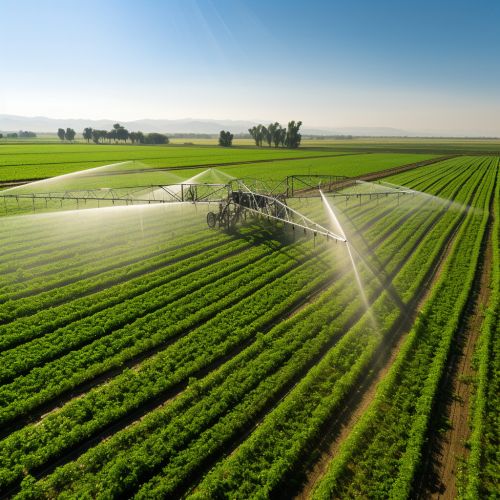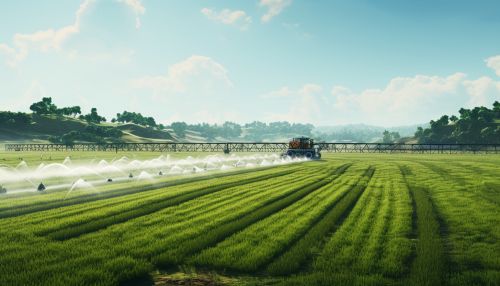Irrigation Efficiency
Introduction
Irrigation efficiency refers to the ratio of the amount of water used in the direct growth of a crop to the total amount of water applied to the field. It is a key concept in the field of irrigation, especially in areas where water is a scarce resource.


Types of Irrigation Systems
There are several types of irrigation systems, each with its own efficiency level. These include surface irrigation, drip irrigation, sprinkler irrigation, and subsurface irrigation.
Surface Irrigation
Surface irrigation is the most common form of irrigation worldwide. In this system, water is applied directly to the soil surface and allowed to infiltrate into the ground. The efficiency of surface irrigation is largely dependent on the uniformity of water distribution, which can be affected by the slope of the field, the soil type, and the rate of water application.
Drip Irrigation
Drip irrigation is a high-efficiency irrigation system that delivers water directly to the root zone of plants. This method minimizes water loss due to evaporation and runoff, making it an ideal choice for water-scarce regions. However, the initial cost of setting up a drip irrigation system can be high, which may deter some farmers from adopting this method.
Sprinkler Irrigation
In sprinkler irrigation, water is applied to the crops in a manner similar to natural rainfall. The water is pumped through a network of pipes and sprayed into the air through sprinklers. While sprinkler systems can be more efficient than surface irrigation, they are still prone to water loss through evaporation and wind drift.
Subsurface Irrigation
Subsurface irrigation involves the application of water below the soil surface, either by direct injection or by raising the water table. This method can be highly efficient as it reduces evaporation losses, but it requires a significant investment in infrastructure and can lead to issues with salinity if not properly managed.
Factors Affecting Irrigation Efficiency
Several factors can affect the efficiency of an irrigation system. These include the type of irrigation system used, the soil type, the crop being grown, the climate, and the management practices employed by the farmer.
Irrigation System
As mentioned earlier, the type of irrigation system used can greatly affect the efficiency of water use. Drip and subsurface irrigation systems generally have higher efficiencies than surface and sprinkler systems.
Soil Type
The type of soil in a field can also impact irrigation efficiency. Sandy soils, for example, have high infiltration rates and can lead to deep percolation losses if irrigation is not properly managed. Clay soils, on the other hand, have lower infiltration rates, which can lead to surface runoff if water is applied too quickly.
Crop Type
The type of crop being grown can also influence irrigation efficiency. Different crops have different water requirements, and some crops can tolerate water stress better than others. For example, rice requires a lot of water and is typically grown in flooded fields, while wheat can be grown with less water and can tolerate some degree of water stress.
Climate
The climate in which the irrigation is taking place can also impact efficiency. In hot and dry climates, evaporation losses can be significant, especially with surface and sprinkler irrigation systems. In humid climates, on the other hand, evaporation losses are less of a concern, but heavy rainfall can lead to runoff and leaching losses.
Management Practices
Finally, the management practices employed by the farmer can greatly affect irrigation efficiency. Proper scheduling of irrigation, regular maintenance of the irrigation system, and the use of technology to monitor soil moisture levels can all help to improve efficiency.
Improving Irrigation Efficiency
Improving irrigation efficiency is crucial for sustainable water management, especially in regions where water is a scarce resource. There are several strategies that can be employed to improve efficiency, including the adoption of more efficient irrigation systems, the use of technology to monitor soil moisture levels, and the implementation of best management practices.
Adopting More Efficient Irrigation Systems
One of the most effective ways to improve irrigation efficiency is to adopt a more efficient irrigation system. As mentioned earlier, drip and subsurface irrigation systems are generally more efficient than surface and sprinkler systems. However, the initial cost of these systems can be a barrier to adoption for some farmers.
Using Technology to Monitor Soil Moisture Levels
Technology can also play a key role in improving irrigation efficiency. Soil moisture sensors, for example, can provide real-time data on soil moisture levels, allowing farmers to apply water only when and where it is needed. This can significantly reduce water waste and improve efficiency.
Implementing Best Management Practices
Finally, implementing best management practices can also help to improve irrigation efficiency. This can include practices such as proper scheduling of irrigation, regular maintenance of the irrigation system, and the use of cover crops to reduce evaporation losses.
Conclusion
Irrigation efficiency is a crucial concept in the field of irrigation, especially in regions where water is a scarce resource. By understanding the factors that affect irrigation efficiency and implementing strategies to improve it, farmers can make the most of their water resources and contribute to sustainable water management.
